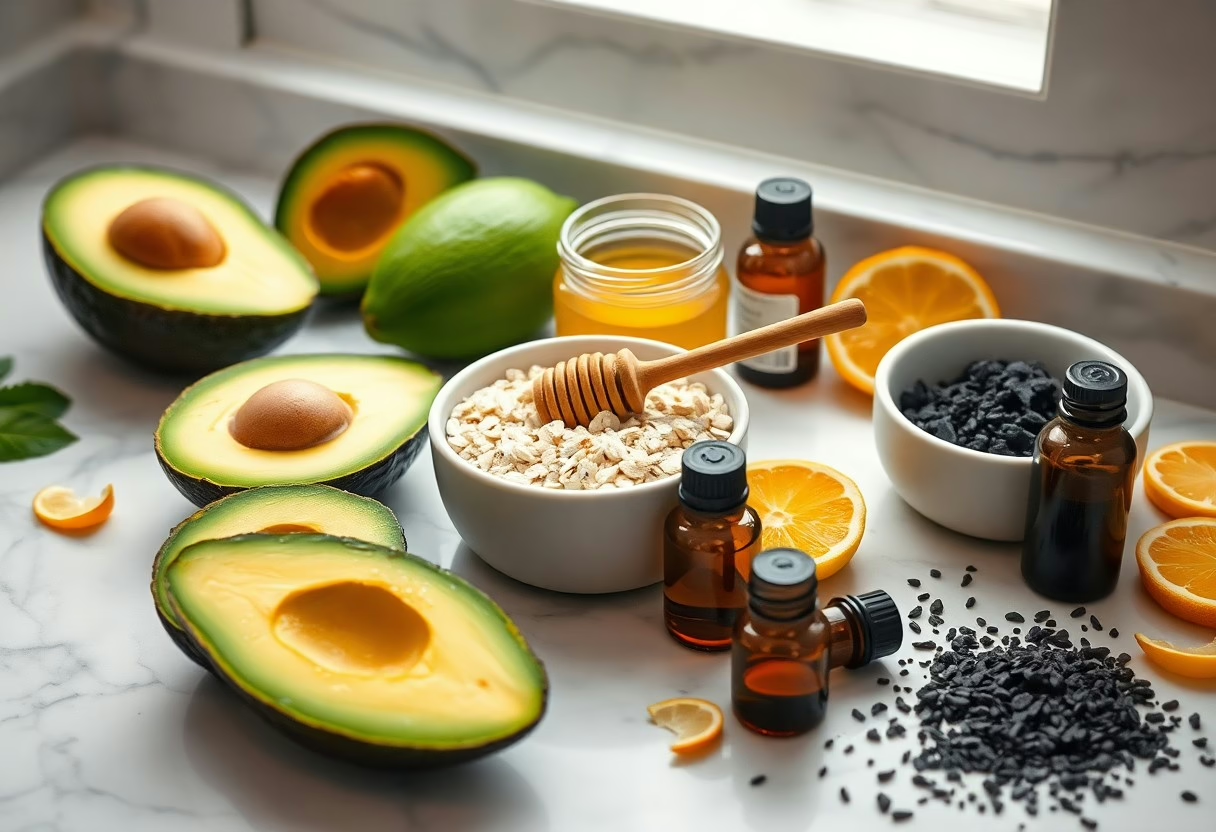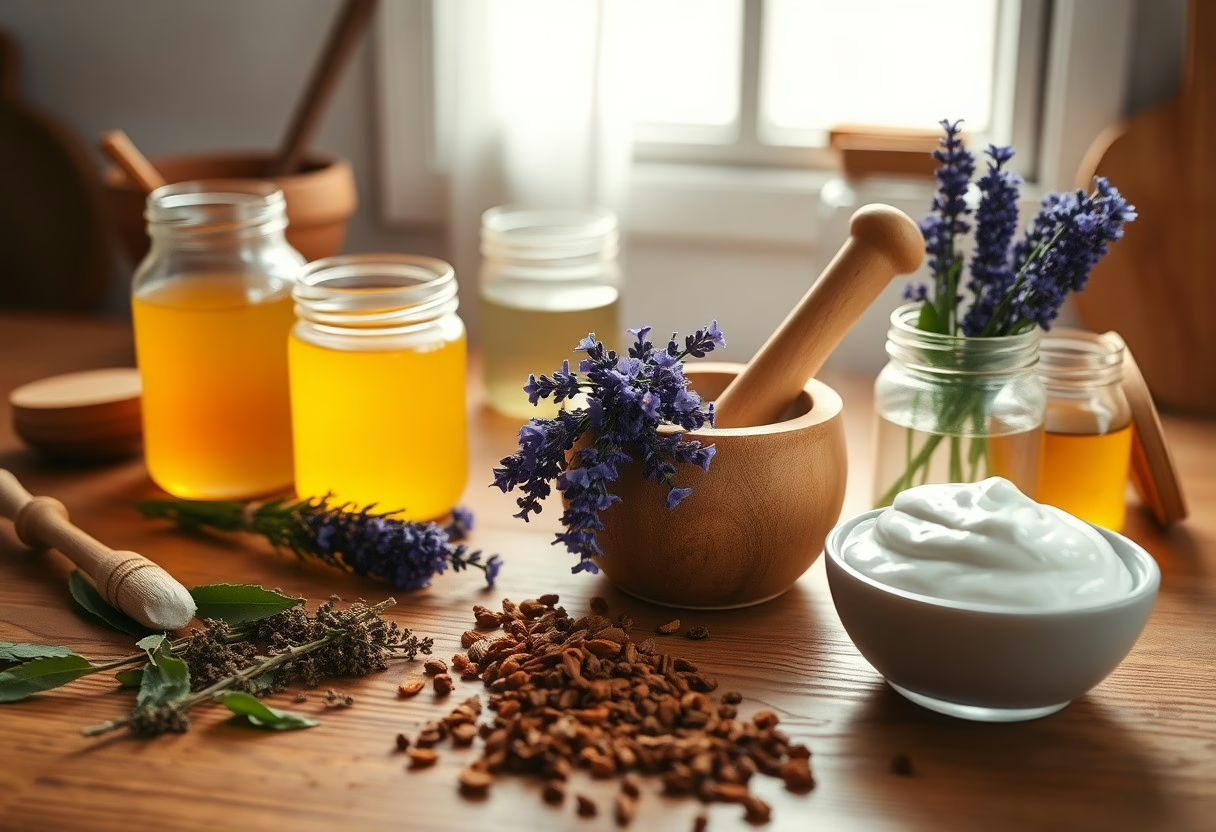Most people are unaware of the benefits of crafting your own skincare products using natural ingredients found in your kitchen. With a few simple recipes, you can create effective, chemical-free treatments tailored to your unique skin type. Not only will these homemade solutions enhance your skincare routine, but they can also save you money and reduce waste. In this post, you’ll discover easy-to-follow recipes that utilize everyday ingredients to nourish and rejuvenate your skin, empowering you to take control of your beauty routine naturally.
Unveiling Nature’s Apothecary
Your kitchen is a treasure trove of plant-based remedies, providing countless opportunities for skincare solutions. Ingredients like olive oil, honey, and turmeric not only elevate your culinary creations but also transform into powerful allies for your skin. By incorporating these everyday items into your skincare routine, you harness the benefits of nature without breaking the bank.
The potency of natural ingredients lies in their unique chemical compositions, which offer various therapeutic benefits for the skin. For instance, honey possesses antimicrobial properties due to its natural enzymes, making it an excellent option for wound healing and acne treatment. Similarly, the antioxidants found in turmeric help combat free radicals, reducing signs of aging.
Each ingredient interacts with your skin at a cellular level, promoting healing and rejuvenation. The lauric acid in coconut oil not only moisturizes but also penetrates the skin, providing antibacterial effects that enhance your skin barrier. The anti-inflammatory compounds in oatmeal soothe redness and irritation, acting as a protective shield against environmental stressors.
Crafting Basic Formulations: A Step-by-Step Guide
Creating your own skincare formulations can be an enjoyable and rewarding experience. By following a few simple steps, you can easily craft effective DIY products that cater specifically to your skin’s needs. Begin by gathering quality ingredients and tools, such as mixing bowls and measuring spoons. Be sure to sanitize your workspace to maintain product integrity.
Facial cleansers are among the easiest skincare products to create at home. For a quick recipe, combine equal parts honey and coconut oil; this blend gently removes dirt and makeup while moisturizing your skin. Another great option is mixing yogurt with a few drops of lemon juice, which can provide a refreshing cleanse.
Nourishing face masks can significantly enhance your skincare regimen, and you can tailor them for your specific skin type. For dry skin, consider a mask made from avocado and honey, as it provides deep hydration. Oily skin might benefit from a blend of clay and tea tree oil, which helps control excess sebum. Sensitive skin can be soothed with oatmeal mixed in yogurt.
Basic Face Mask Guidelines:
- Combine ingredients until well blended to ensure even application
- Apply your mask to clean, dry skin for maximum effectiveness
- Leave on for 15-20 minutes before rinsing with warm water
- Adjust ingredient ratios based on texture or scent preference

Breaking Down Essential Oils: Aromatherapy for Skin Health
Essential oils play a significant role in natural skincare, offering therapeutic benefits that enhance your skin health. These highly concentrated plant extracts can effectively address various skin concerns, such as dryness, acne, or aging signs. With every drop, they carry healing properties that can invigorate your skincare routine.
Choosing the right essential oils requires an understanding of your skin type and the issues you wish to tackle. For oily skin, tea tree oil provides anti-inflammatory and antibacterial benefits, while lavender oil is fantastic for sensitive skin, calming irritation and promoting healing. If you’re aiming for hydration, consider rose or geranium oils that help balance moisture levels.
Incorporating essential oils into your skincare routine demands a careful approach to ensure safety and effectiveness. Dilution is crucial; always blend oils with a carrier oil, like jojoba or almond oil, before applying them directly to your skin. A general guideline is to use 1-2 drops of essential oil per teaspoon of carrier oil. Conduct a patch test to check for allergies or sensitivities.
Beyond the Beauty: Environmental and Ethical Benefits
Opting for natural skincare products not only enhances your beauty routine but also promotes a healthier planet and ethical practices. By using ingredients derived from nature, you are supporting sustainable farming methods, which often prioritize ecological balance and biodiversity.
Creating your own skincare at home significantly cuts down on packaging waste. Most store-bought products often come in plastic containers that contribute to landfill overflow. By using simple, natural ingredients, you can minimize waste and repurpose containers, making your skincare routine more environmentally friendly.
Using local ingredients in your skincare products fosters community economies and reduces your carbon footprint associated with transportation. Sourcing herbs, oils, and other raw materials from local farms not only supports eco-friendly practices but also ensures freshness and potency in your formulations.
Real-Life Transformations: Success Stories
Real users have experienced remarkable results by embracing natural skincare. From resolving stubborn acne to nourishing dry skin, the success stories are as diverse as the individuals behind them. These testimonials showcase how simple kitchen ingredients and essential oils have transformed not just complexions, but also confidence.
Individuals who have transitioned to natural skincare often share inspiring tales of revitalized skin health. One user reported a complete turnaround from an uneven, dry complexion to radiant, supple skin after incorporating a honey and oatmeal mask into her routine. Another enthusiast found that making her own moisturizer significantly reduced her eczema flare-ups.
Natural skincare, while beneficial, can present a few hurdles. Adaptation to homemade products, ingredient sensitivities, and the commitment to consistency are some challenges you may encounter. However, gradual incorporation of new recipes into your regimen makes the transition smoother. Keeping a skincare diary helps track reactions, allowing you to adjust recipes based on your unique skin type.
Conclusion
Drawing together the knowledge shared in this guide, you now have the tools to confidently create natural skincare products at home. By using simple ingredients and tried-and-true recipes, you can enhance your beauty routine while ensuring that you know exactly what goes on your skin. Embracing natural skincare not only benefits your skin but also fosters self-care and mindfulness in your daily life. You are empowered to take control of your skincare journey, making choices that align with your values and preferences.

